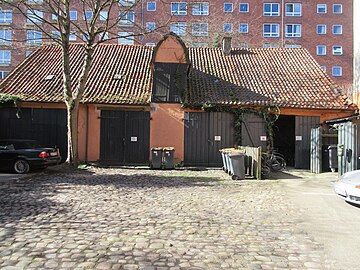Hedemann and the new buildings
The property was later acquired by sugar manufacturer Christoph Hedemann (1780-). The present building on the site was constructed for him in 1832. [1] The adjacent building at No. 79 was built for Hedemann the following year. [2]
No. 64 A was home to four households at the 1834 census. Christoph Hedemann occupied the first floor, basement and side wing. He lived there with his wife Clara Sophie Hedemann (née Gosch), their 15-year-old foster daughter Carl August Hedemann-Gade, husjomfru Mathea Susanne Rick, office clerk Christian Heinrich Hermann Meyer, six sugar refinery workers, four male servants and two maids. [3] Josias Feddersen, the king's cabinet secretary, resided on the second floor with his wife Wibecke Birgitte Feddersen født Krey, their eight children (aged three to 17), one male servant and two maids. [4] August Frederik Howitz, another employee in the royal cabinet secretariate, resided on the third floor with his wife Mariane Howitz født Holmer and one maid. [5] Johann Rudolph Hertz, Hedemann's sugar master (manager), resided on the same floor with his wife Angelica Emilie Hertz /née Kaasbøll( and one maid. [6]
Frederik Christian Holsten-Lehn-Charisius
In 1844, No. 64 was divided into two separate properties, No. 64A (Store Kongensgade 77) and No. 64B (Store Kongensgade 79).
No. 64A was (at some point) acquired by Frederik Christian Holsten-Lehn-Charisius (1796-1999) He was the son of admiral Hans Holsten and Regitze Sophie Kaas (af Mur). In 1820, he had married Pauline Christine Elisabeth Rantzau-Lehn )19+3-1960). Since his wife had no brothers, he had sicceeded his father-in-law as Baron of Lehn. It was not until 1879 that "Charisius" was not added to his last name.
At the time of the 1845 census, No. 64A was home to 38 residents in five households. Hans Baron Holsten, an admiral in the Royal Danish Navy, resided on the first floor with naval lieutenant in the 5th Vatallion G. F. Kiær, three male servants and three maids. [7] August Sophus Georg Tramp, a kammerjunker at the Queen's Court, resided on the second floor with his wife Julie Sophie Frederikke Tramp, their three children (aged zero to four), one male servant and three maids. [8] Peter Wilhelm Tegner, a captain in the Royal Danish Navy, resided on the third floor with his wife Johanne Catrine Cecilie Tegner, their seven children (aged two to 23), his sister-in-law Petronelle Marie Hansen and two maids. [9] Camillus Mullerts, a chief physician in the Royal Danish Nacy, resided on the ground floor with his wife Hedevig Antoinette Mullerts, their eight children (aged one to 18), three maids and law student Adam Frederik Moltke. [10] Ferdinand Hansen, a concierge, resided in the basement with his wife Emilie Wilhellemine Bigun and their four-year-old daughter. [11]
Lawyer and politician Christian Albrecht Bluhme resided in the building from 1846 to 1849. The economist and politician Christian Georg Nathan David (1793–1874) was a resident in the building from 1858 to 1861. He headed Statistisk Bureau (now Danmarks Statistik) from 1854 to 1873.
At the time of the 1860 census, No. 64A was again home to five households. Camillus and Hedvig Müllertz still resided in the building with five of their children (aged 18 to 33), Camillus Konopka and Julie Amalie Konopka, one male servant and two maids. [12] C. N. David (1683-1873), a politician and national economist, resided in the building with his wife Georgine David, their five children (aged 12 to 23) and two maids. [13] Fritz Fredericksen Kiær, a kammerjunker and ritmester, resided in the building with his wife Anna Augusta Wilhelmine Kiær (née Riis), their four children (aged four to 13) and four maids. [14] Adam Wilh. Bartholdy (1715-1874), a grocer (urtelræmmer), resided in the building with his wofe Wilhelmine Bartholdy, their two children (aged 10 and 12), his sister Marie Bartholdy, his cousin Wilhelmine Rode and two maids. [15] Ferdinand Hansen, a concoerige, resided in the basement with his wife Emilie Wilhelmine Hansen *f. Bigum and their three children (aged six to 18). [16]
Sehestedt-Juul, 1863–1901
In 1863, Frederik Christian Holsten-Lehn-Charisius sold the property to Ove Sehestedt-Juul- The new owner was married to his niece Emilie Holstein. Sehestedt-Juul's son kept the building until 1901. [17]
Counter Admiral Edouard Suenson (1805–1887)—commemorated for his role in the Battle of Heligoland —was among the residents from 1868 to 1880.
The painter Otto Bache resided in an apartment in the rear wing from 1873 to 1882 and again from 1887 to 1888. His studio was also located in the building. [18] Otto Bache and Ove Sehestedt-Juul were personal friends. Bache had painted a number of portrait paintings of the family. The apartment and studio was therefore put at his disposal at a very low rent. [17]
Otto Erichsen and Jacob Johan Simonsen opened a dairy shop in the building in 1878. It was from 1935 continued by O. Sørensen (born 1899) under his own name. The shop was for a while appointed as purveyor to the Court of Denmark. [19]





